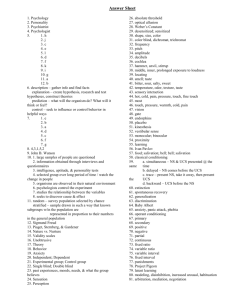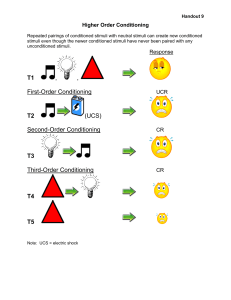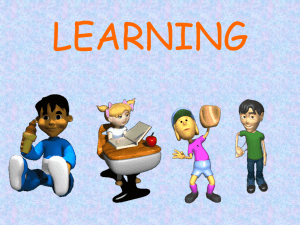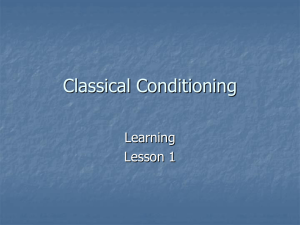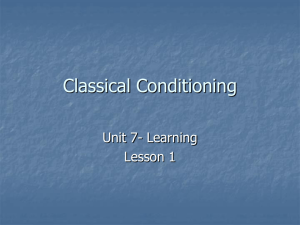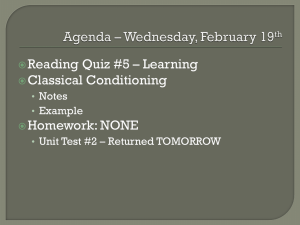Classical Conditioning II Generalization and Discrimination
advertisement
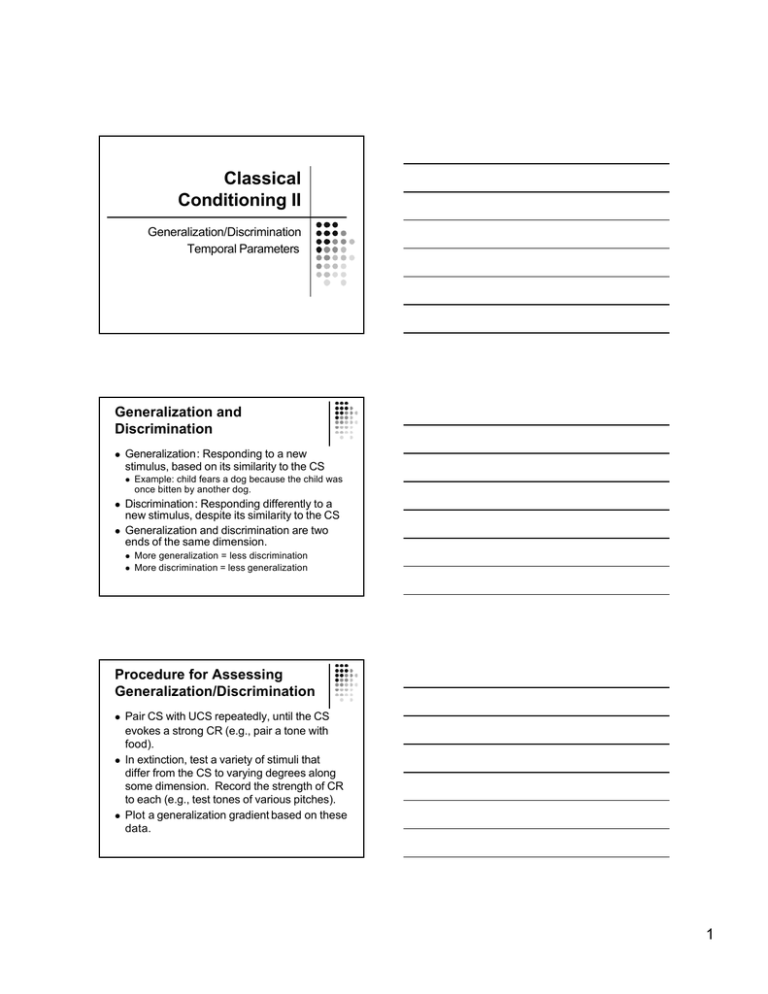
Classical Conditioning II Generalization/Discrimination Temporal Parameters Generalization and Discrimination l Generalization: Responding to a new stimulus, based on its similarity to the CS l l l Example: child fears a dog because the child was once bitten by another dog. Discrimination: Responding differently to a new stimulus, despite its similarity to the CS Generalization and discrimination are two ends of the same dimension. l l More generalization = less discrimination More discrimination = less generalization Procedure for Assessing Generalization/Discrimination l l l Pair CS with UCS repeatedly, until the CS evokes a strong CR (e.g., pair a tone with food). In extinction, test a variety of stimuli that differ from the CS to varying degrees along some dimension. Record the strength of CR to each (e.g., test tones of various pitches). Plot a generalization gradient based on these data. 1 Generalization Gradient CS Drops of Saliva 30 25 20 Less responding due to discrimination 15 10 Responding due to generalization 5 0 900 950 1000 1050 1100 Tone Frequency (Hz) Example of Complete Generalization CS Drops of Saliva 30 25 20 15 Other stimuli responded to as strongly as the original CS 10 5 0 900 950 1000 1050 1100 Tone Frequency (Hz) Example of Complete Discrimination Maximum response to CS Drops of Saliva 30 25 20 No response to other stimuli 15 10 5 0 900 950 1000 1050 1100 Tone Frequency (Hz) 2 Importance of Generalization and Discrimination l Generalization allows us to respond adaptively when we encounter situations similar to those we have experienced before. l l “If one dog bit us, maybe this one will, too. Better be careful!” Discrimination allows us to respond differently after we have had experience with the new situation. l “Hey, this dog is friendly. No need to worry!” Temporal Parameters: Effect of Order and Timing of Stimuli l Classical conditioning procedures differ in the order and timing of CS and UCS, and in their effects. Procedures include: l Forward conditioning l l l l l Delay conditioning Trace conditioning Simultaneous conditioning Backward conditioning Temporal conditioning Delay Conditioning l l l The CS begins, continues for some time, then ends with the delivery of the UCS. This is the most effective procedure, if the delay between the start of the CS and the delivery of the UCS is optimal (5-10 seconds for salivary conditioning). Making the delay longer or shorter than the optimal reduces effectiveness. 3 Trace Conditioning l l l CS appears briefly (e.g., 1 second), followed by a trace interval (during which the CS and UCS are both absent), ending with delivery of the UCS. Effective, but less so than delay conditioning with the same interval between the start of the CS and delivery of the UCS. Pavlov thought that association between CS and UCS was weakened because the CS was not present when the UCS occurred. Simultaneous Conditioning l l l l The CS and UCS are presented together, as a unit (i.e., simultaneously). This procedure maximizes the temporal contiguity between CS and UCS, so one might expect it to be highly effective. However, it is almost completely ineffective. Thus, it appears that, to be effective, the CS must act as a signal for the UCS. Backward Conditioning l l l The UCS is presented first, then the CS. (This reverses the usual order, thus the name backward conditioning.) Pavlov thought that this procedure was ineffective. However, Pavlov was wrong. This procedure transforms the CS into an inhibitory stimulus. An inhibitory CS has to power to suppress a response rather than evoke one. 4 Temporal Conditioning l l l l This procedure is unusual in that there is no explicit CS being presented by the experimenter. The UCS is presented at regular intervals (e.g., once every 30 seconds). After many UCS deliveries, the subject begins to produce a CR just before each UCS delivery. Internal, time-correlated stimuli can function as an implicit CS. 5
